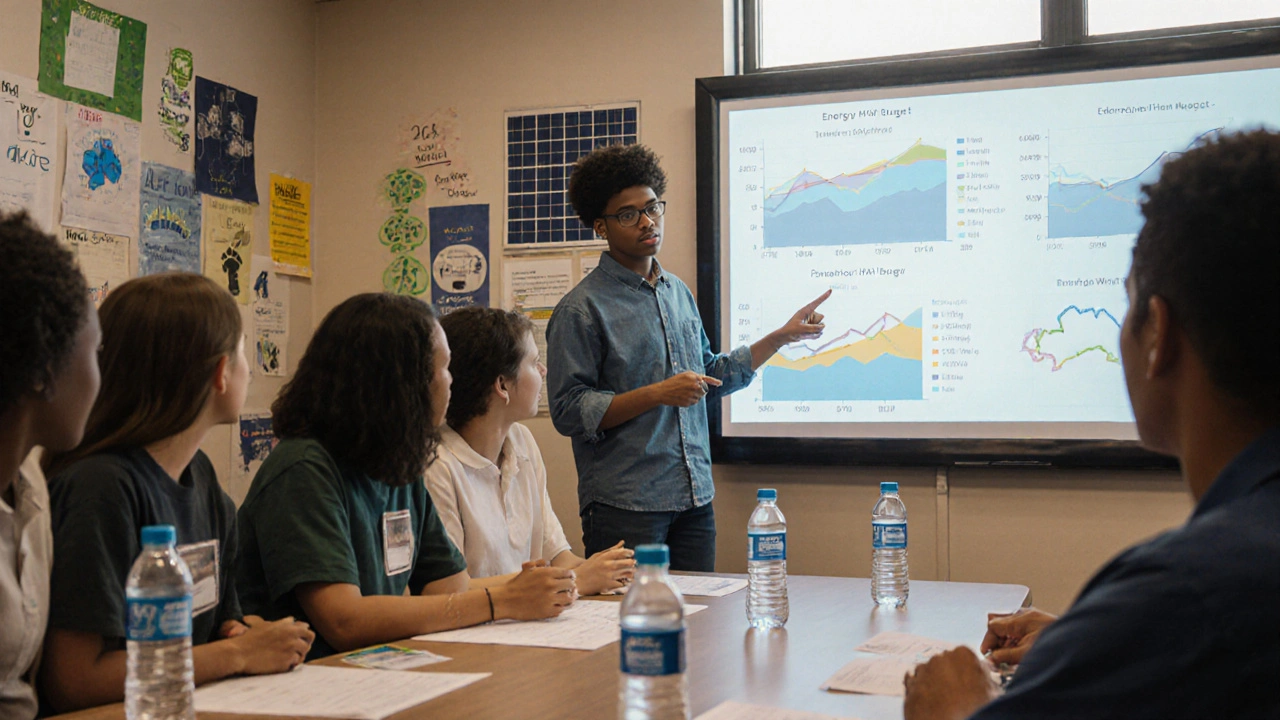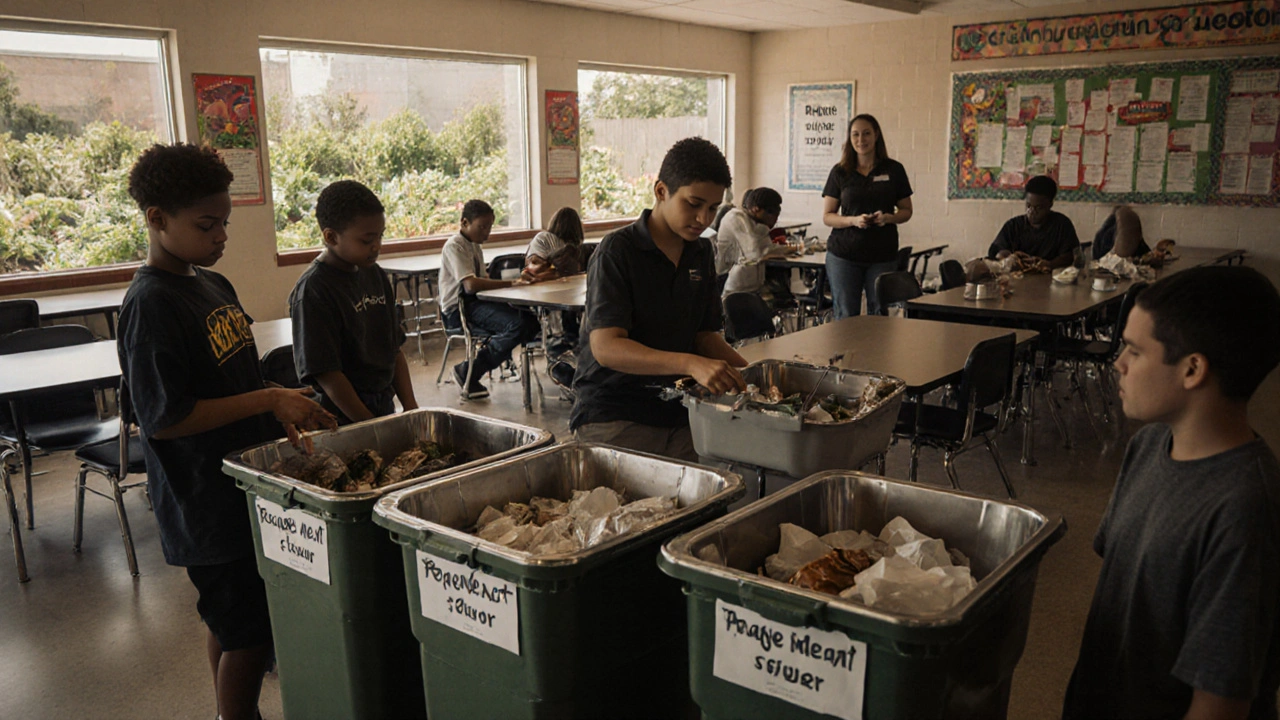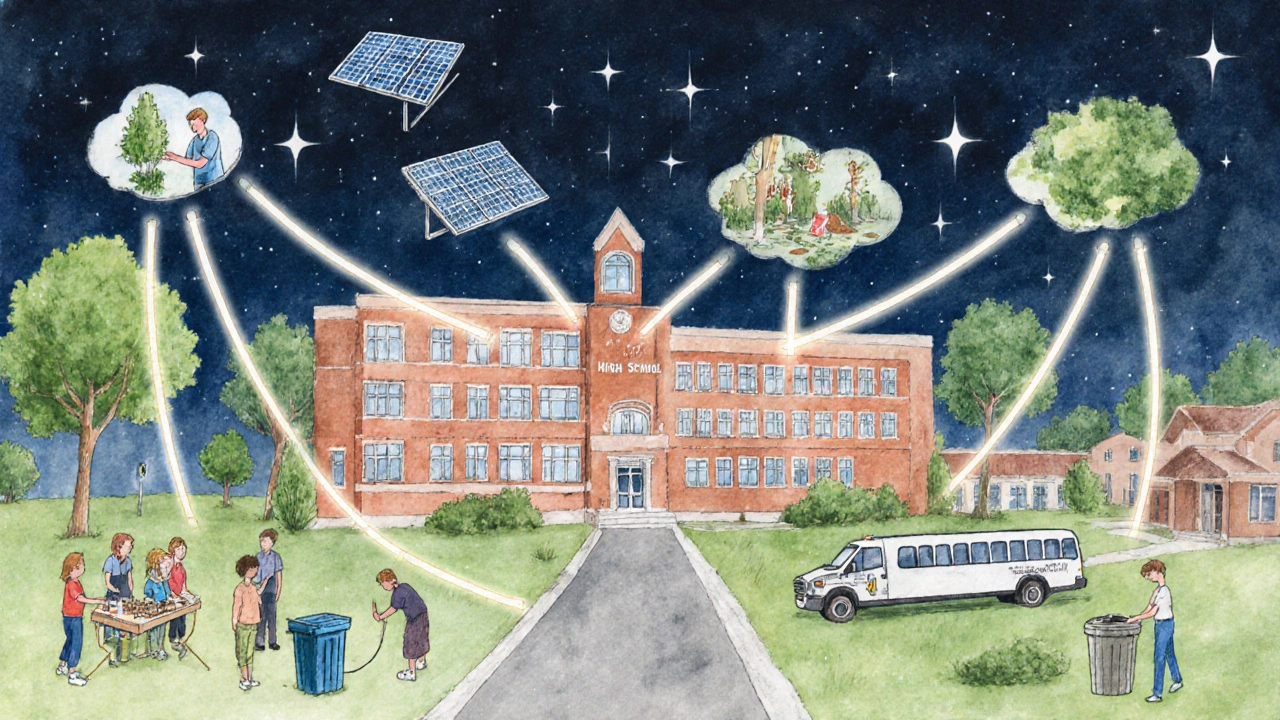Can High Schools Help Mitigate Climate Change? Here's How Students and Staff Are Making a Difference

High schools aren’t just places where students learn algebra and write essays-they’re also hubs of real-world action. On any given day, students in classrooms across the country are organizing recycling drives, pushing for solar panels on their roofs, and demanding their cafeterias stop serving single-use plastics. These aren’t isolated efforts. They’re part of a quiet but powerful movement: high schools stepping up to fight climate change.
Students Are Leading the Charge
It’s not adults in suits writing policy papers-it’s teenagers. In 2024, over 1,200 U.S. high schools had student-led climate clubs that pushed for tangible changes. At Lincoln High in Portland, Oregon, students surveyed their school’s energy use and found that idle HVAC systems were wasting 30% of their electricity. They presented data to the school board, got approval for smart thermostats, and cut energy costs by $18,000 in one year. That money went straight into funding a student environmental internship program.
These aren’t just feel-good stories. They’re practical solutions built by people who live in the building every day. Students notice when the lights stay on in empty classrooms. They see how much food gets thrown out at lunch. They know which vending machines sell sugary drinks and which ones don’t. Their insights are grounded in daily reality, not theory.
Schools Can Cut Emissions-Fast
Public schools in the U.S. spend more than $8 billion a year on energy. That’s more than the entire annual budget of 12 U.S. states. Most of that energy comes from fossil fuels. But switching to clean energy doesn’t require waiting for federal funding. Many schools are doing it themselves.
In 2023, the San Diego Unified School District installed solar panels on 87 of its 138 campuses. The project cost $110 million, but it was fully funded by state grants and long-term power purchase agreements. Now, those schools generate 75% of their own electricity. The district saved $2.4 million in its first year alone-and that money went back into hiring more science teachers.
Even small changes add up. Replacing incandescent bulbs with LEDs cuts lighting energy use by 80%. Installing low-flow faucets and toilets reduces water use by 40%. These aren’t expensive upgrades. Many cost less than $5,000 and pay for themselves in under two years.
Curriculum Isn’t Just About Science
Climate change isn’t just a science topic-it’s a math problem, an economics lesson, a civics issue, and a history lesson all at once.
At Roosevelt High in Minneapolis, students in AP Environmental Science don’t just read about carbon footprints-they calculate their own. Each student tracks their household’s energy use, transportation habits, and food choices over a month. Then they compare it to the average American and propose realistic reductions. The class doesn’t end with a test. It ends with a school-wide campaign to reduce meat consumption by 20% in the cafeteria.
Other schools are integrating climate literacy into every subject. English classes analyze climate journalism. History classes study the 1970s environmental movement. Business classes model the cost of carbon taxes. This isn’t activism-it’s education that connects learning to real life.

What Schools Can Actually Do-Without a Big Budget
You don’t need a million-dollar grant to make a difference. Here’s what actually works:
- Start a student-led Green Team. It only takes five passionate kids to begin. Their job? Identify one waste stream (plastic bottles, food waste, paper) and fix it.
- Switch to reusable dishware in the cafeteria. Many schools use disposable trays and utensils. Switching to washable ones cuts waste by 90% and saves money over time.
- Launch a school garden. Growing even a few vegetables reduces food miles and teaches students where food comes from. In Chicago, one high school garden supplies 30% of the salad bar.
- Push for a school-wide recycling and composting program. Over 60% of school waste is compostable. Most districts don’t collect it-but they can start with one building.
- Ask for energy audits. Many states offer free energy assessments for public schools. Use the report to find low-cost fixes.
These aren’t radical ideas. They’re simple, proven, and scalable. And they’re already working in schools with budgets as tight as $2 million a year.
Teachers Are the Hidden Engine
Behind every successful school climate initiative is a teacher who stayed late, wrote the grant, or convinced the principal to say yes. In 2024, a national survey of 1,800 U.S. teachers found that 68% had led or supported a climate-related project-even if it wasn’t part of their job description.
One biology teacher in rural Georgia turned her classroom into a lab for testing local water quality. Students collected samples from nearby creeks, sent them to a university lab, and presented findings to the county council. The council funded a cleanup project based on their data.
Teachers don’t need to be climate scientists. They just need to be willing to say, “Let’s try this.”
The Bigger Picture: Schools as Community Hubs
High schools don’t exist in a bubble. They’re often the largest public buildings in a town. That means they can serve as centers for broader climate action.
In Boulder, Colorado, the high school opened its gym to host a community tool library. Residents can borrow repair kits, solar chargers, and rain barrels. The school also hosts monthly workshops on home energy efficiency-open to anyone in the neighborhood.
When schools become community anchors, their impact multiplies. A student who learns to compost at school teaches their parents. A parent who attends a solar panel workshop tells their neighbor. One small change ripples outward.

Why This Matters More Than You Think
Climate change isn’t a future problem. It’s happening now. And young people know it. A 2025 Pew Research study found that 73% of U.S. teens say climate change is a major threat to their future. But only 29% feel adults are taking it seriously.
High schools are where that gap closes. When students see their school taking real action-when they’re part of the solution-they stop feeling powerless. They start believing change is possible.
And that’s the most important thing any school can do: give students the proof that their voices matter.
What Doesn’t Work
Not every green initiative succeeds. Some schools install solar panels but never teach students how they work. Others hand out reusable water bottles but don’t fix the broken water fountains. These efforts look good on paper-but they don’t change behavior.
Real change needs three things: ownership, transparency, and action. Students need to know the goal, track progress, and see results. If the school says it’s going green but the trash bins still have plastic bottles mixed in, students will stop caring.
Don’t do it for the photo op. Do it because it’s the right thing to do-and because students will hold you accountable.
Can high schools really make a difference in climate change?
Yes. While individual schools won’t stop global emissions overnight, they can cut their own carbon footprint by 30-60% with simple changes. More importantly, they train a generation of students who will carry these habits into colleges, jobs, and communities. A student who learned to compost in high school is far more likely to push for recycling at work later.
What’s the biggest barrier to climate action in high schools?
Money isn’t the main problem-it’s inertia. Most schools have the budget for LED bulbs, compost bins, or energy audits. What’s missing is someone to take the first step. Student-led initiatives that present clear data and low-cost solutions are the most effective way to break through bureaucracy.
Do climate projects distract from academics?
No-they enhance them. Students working on school sustainability projects use math to calculate energy savings, write reports for the school board, analyze data in science class, and debate policy in government. These aren’t side projects. They’re applied learning that deepens understanding across subjects.
Are there any federal programs to help schools go green?
Yes. The U.S. Department of Education offers grants through the Green Ribbon Schools program. Many states also have energy efficiency funds for public schools. In 2025 alone, over $200 million in state and federal grants were awarded to K-12 schools for sustainability projects. Most require a student-led component.
How can parents support climate efforts at their child’s school?
Ask questions. Attend school board meetings. Volunteer to help with a garden or recycling drive. Offer to connect the school with local environmental groups or businesses that donate supplies. You don’t need to be an expert-just show up and say, “I want to help.”
Final Thought: It’s Not About Perfection
High schools won’t solve climate change. But they can be where millions of young people learn that action matters. One school starts composting. Another replaces its buses with electric ones. A third stops selling soda. These aren’t grand gestures. But together, they add up.
And for the students who make it happen? They’re not just learning about the future. They’re building it-right now, in their own hallways, cafeterias, and classrooms.
Tasha Hernandez
November 17, 2025 AT 08:17Oh wow, another feel-good story about teens saving the world while their parents pay the electric bill. Let me grab my tissue box-because nothing says ‘hope for humanity’ like a bunch of 16-year-olds micromanaging cafeteria trash cans. Next they’ll be designing the next IPCC report between algebra quizzes. I’m crying. Actually, no, I’m not. I’m just scrolling past this like it’s another sponsored post from Patagonia.
Anuj Kumar
November 17, 2025 AT 18:41schools are not for climate. schools are for math and reading. this is communist brainwashing. solar panels on roof? who paid? china? i think so. students dont know anything. they just follow trends. this is fake news.
Christina Morgan
November 18, 2025 AT 15:54Actually, this is one of the most grounded, practical pieces of education journalism I’ve read all year. The fact that students are identifying real inefficiencies-like HVAC running in empty rooms-and then fixing them with data? That’s not activism. That’s systems thinking. And the part about teachers staying late to run water tests in rural Georgia? That’s the quiet heroism we don’t celebrate enough. These aren’t ‘green projects.’ They’re life skills in disguise.
Kathy Yip
November 20, 2025 AT 10:53i just wonder… if students are so invested in this stuff, why do so many schools still have single-use plastic utensils? is it really about inertia or just… lack of follow through? like, they get excited for a week, then forget. maybe the real issue is sustaining momentum, not starting it. also, i think the word ‘compostable’ gets thrown around too much. most of that stuff needs industrial facilities to break down. in small towns? it just ends up in the landfill anyway.
Bridget Kutsche
November 22, 2025 AT 07:05Hey, I’m a middle school science teacher in Ohio, and this resonates so hard. Last year, my students did a waste audit and found we were throwing out 120 lbs of food per day. We started a compost bin in the back courtyard-parents helped build it, the custodian showed us how to layer it, and now we use the compost in the school garden. No grant. No fancy tech. Just a bunch of kids who didn’t want to feel like their lunch was a crime. It’s messy. It’s imperfect. But it’s real. And yeah, the kids remember it longer than any standardized test.
Jack Gifford
November 22, 2025 AT 10:16Just a quick note on grammar: ‘They’re part of a quiet but powerful movement’-correct. But ‘students in classrooms across the country are organizing’? That’s a dangling modifier. It’s not the classrooms organizing, it’s the students. Minor, but it’s the kind of thing that makes this piece feel less polished than it could be. Still, the content’s solid. Love the part about the school garden supplying 30% of the salad bar. That’s the kind of stat that sticks.
Sarah Meadows
November 22, 2025 AT 21:59Let’s be real-this is part of the globalist agenda to undermine American sovereignty. Schools are being weaponized to indoctrinate children into eco-socialist dogma under the guise of ‘education.’ The U.S. Department of Education handing out $200 million in grants? That’s taxpayer money funding a radical agenda. Where’s the oversight? Who’s auditing these so-called ‘student-led initiatives’? This isn’t sustainability-it’s cultural engineering.
Nathan Pena
November 24, 2025 AT 10:04The data presented here is superficial at best. Yes, LED bulbs reduce energy consumption by 80%-but that’s relative to incandescents, which were phased out federally in 2012. The $18,000 savings from smart thermostats? That’s negligible when scaled across 100,000 U.S. public schools. The real emissions impact is statistically insignificant. Meanwhile, the narrative romanticizes student labor as ‘empowerment’ while ignoring the structural failures of underfunded districts. This is performative pedagogy dressed up as environmentalism.
Mike Marciniak
November 25, 2025 AT 18:13They say students are leading this movement. But who funds the climate clubs? Who trains the teachers? Who’s behind the grant applications? I’ve seen the paperwork. It’s all tied to the same three NGOs that also run the summer camps and the college prep programs. This isn’t grassroots. It’s orchestrated. And the schools? They’re just the delivery system. They’re not saving the planet-they’re being used as test sites for a larger political rollout.
VIRENDER KAUL
November 26, 2025 AT 01:44It is a matter of profound concern that educational institutions are being diverted from their primary function of academic instruction to engage in extracurricular activism. While the intent may appear benevolent, the systematic redirection of institutional resources toward environmental initiatives undermines the foundational purpose of schooling. The emphasis on student-led projects, though rhetorically appealing, lacks pedagogical rigor and often results in superficial outcomes. Moreover, the normalization of such activities may foster a culture of performative virtue rather than substantive intellectual development.
Mbuyiselwa Cindi
November 28, 2025 AT 01:34I’m from Cape Town and we’ve got schools here doing exactly this-students running compost bins, fixing leaky taps, even teaching their grandparents how to sort recycling. It’s not about saving the world tomorrow. It’s about teaching kids that small actions, done consistently, add up. My niece started a ‘no plastic bottle’ challenge at her school. Now the whole neighborhood brings refillable bottles to the community center. That’s the ripple effect. You don’t need a million dollars. You just need someone to say, ‘Let’s try this.’ And then do it.